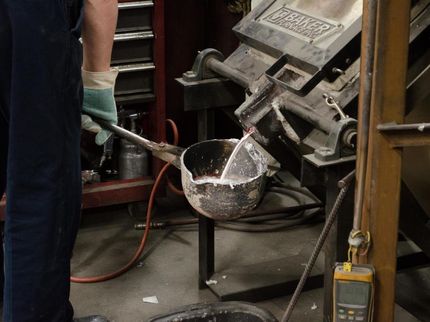Addition of rare earths influences the behaviour of sheet metal
Junior Scientist Award for Magnesium Researcher
Advertisement
Lennart Stutz, a magnesium researcher at the Helmholtz Centre Geesthacht, was awarded a young scientist prize for the best publication of the year 2011,at the Annual Meeting of the international “Minerals, Metals & Materials Society” (TMS) which was held in Orlando, Florida in March of this year.
In his prize-winning paper the doctoral student Lennart Stutz examined the influence of texture on the formability of magnesium alloy sheets containing rare earth additions (Alloy ZE10). Metal sheets are utilized in the construction of vehicles, whether they are made of steel, aluminium or, in future, magnesium.
When, a mudguard is manufactured from a sheet of metal, for example, this is referred to by the experts as sheet metal forming. The term formability applies to the ability of the sheet to attain the required shape without tearing. The magnesium alloy ZE10 has better formability than conventional alloys. However, very little research has been conducted on the properties of ZE10 to date. The paper published by the Geesthacht material scientist will provide greater clarity.
Prof. Dr. Karl Ulrich Kainer, director of the Geesthacht Magnesium Innovations Centre (MagIC), commented: “A very good paper has been honoured with this major junior scientist award. I am naturally delighted about this. The system ZE10 was well known but there had been no comprehensive studies of the properties.” Moreover, the prize itself has a signalling effect. TMS is a global society of approx. 10,000 material scientists and students from 70 countries. More than 4,000 members travelled to Florida to take part in the annual meeting.
Test carried out and diagram compiled
The formability of sheet metal is generally determined by means of established test procedures. However, there was no available data for the alloy ZE10 which provided evidence of the sheet metal properties. Lennart Stutz drew up a so-called Forming Limit Diagram in the course of his work by carrying out tests on ZE10 discs.
In these tests a special pattern is sprayed onto the surface of a metal sheet. Then the piece of metal is stretched over a punch. The deformation is photographically measured on the basis of the extension of the reference points which have been previously sprayed on. This procedure was carried out by the doctoral student Lennart Stutz at different temperatures. Thus, for the first time, reliable statements can be made regarding the behaviour of a ZE10 sheet during the forming process.
Alloy ZE10
This magnesium alloy contains a low level of rare earth addition, in particular cerium and lanthanum with a percentage content of 0.1 to 0.2 percent by weight. E stands for rare earths; Z for zinc. The proportion of zinc in the alloy is 1 percent. The utilization of this alloy in modern vehicle construction has recently become a focus of interest for engineers, as the addition of this small amount of rare earths improves the forming capability.
Texture of sheet metal
The texture of metallic alloys has a fundamental influence on the properties. The term texture refers to the alignment of the grains. The grains are crystallites from which the metal is built up. They show characteristic lattice structures. The behaviour of the material changes according to the alignment of the individual grains within the alloy. If all the grains are aligned in a parallel way in the sheet metal plane, the metal sheet is brittle and breaks in the forming process. It is better if the grains are oriented in different directions. This property can be achieved by the addition of rare earths to the magnesium metal sheets.
Magnesium Innovations Centre MagIC
On the globally unique research platform, Magnesium Innovations Centre MagIC, intensive research is being carried out into the magnesium technologies of the future. Magnesium can assist in the production of weight-reduced and thus fuel-saving and environmentally-friendly cars. Today, magnesium is already present in steering wheels and dashboards. Due to the excellent casting properties of magnesium alloys, even complex constructions can be produced in a single casting. Nevertheless, research must be intensified even further. How stable does the material remain in the case of an accident? What can be done to effectively deal with corrosion? How can the rolling of the sheet material be improved? The scientists at the Magnesium Innovations Centre are seeking answers to such questions.
The Minerals, Metals & Materials Society (TMS)
The largest association of material scientists worldwide: the society has more than 10,000 members in over 70 countries. Approx. 4,000 members attend the annual meeting. The headquarters of this prestigious society is Warrendale, near Pittsburgh, Pennsylvania,USA.





























































